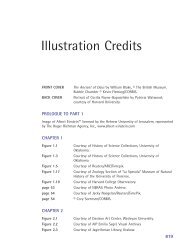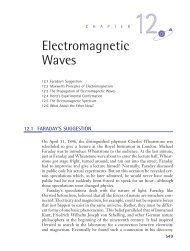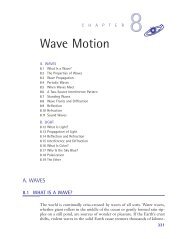Chapter 9: Einstein and Relativity Theory (319 KB) - D Cassidy Books
Chapter 9: Einstein and Relativity Theory (319 KB) - D Cassidy Books
Chapter 9: Einstein and Relativity Theory (319 KB) - D Cassidy Books
Create successful ePaper yourself
Turn your PDF publications into a flip-book with our unique Google optimized e-Paper software.
3637_<strong>Cassidy</strong>TX_09 6/14/02 12:08 PM Page 431<br />
9.9 RELATIVITY OF MASS 431<br />
9.9 RELATIVITY OF MASS<br />
You saw in Section 3.4 that inertial mass is the property of objects that resists<br />
acceleration when a force is applied. The inertial mass, or simply “the<br />
mass,” is the constant of proportionality between force <strong>and</strong> acceleration in<br />
Newton’s second law of motion<br />
F net ma.<br />
Therefore a constant force will produce a constant acceleration. So, once<br />
an object is moving, if you keep pushing on it with the same force, it will<br />
keep accelerating, going faster <strong>and</strong> faster <strong>and</strong> faster without limit, according<br />
to this formula. Newton’s second law thus contains no speed limit. But<br />
this is inconsistent with the relativity theory, which imposes a speed limit<br />
for objects in space of about 300,000 km/s (186,000 mi/s), the speed of<br />
light. The way out is to amend Newton’s second law. <strong>Einstein</strong>’s way was to<br />
note that m, the inertial mass, does not stay constant but increases as the<br />
speed increases—as in fact is experimentally observed, for example, for<br />
high-speed elementary particles. When the speed increases, it takes more<br />
<strong>and</strong> more force to continue the same acceleration—eventually an infinite<br />
force trying to reach the speed of light. <strong>Einstein</strong> deduced from the two postulates<br />
of special relativity theory that the inertia of a moving object increases<br />
with speed, <strong>and</strong> it does so in the same way as the time relation in<br />
time dilation. (The derivation is provided in the Student Guide for this chapter.)<br />
Using our familiar square root factor, we can write<br />
m s<br />
m m .<br />
1 /c v<br />
2<br />
2<br />
Here m m is the mass of the object in relative motion, <strong>and</strong> m s is the mass of<br />
the same object before it starts to move. Often m s is called the “rest mass.”<br />
Similarly to the measurement of time intervals, as an object’s speed increases<br />
the mass as observed from a stationary reference frame also increases.<br />
It would reach an infinite (or undefined) mass if it reached the speed of light.<br />
This is another reason why anything possessing mass cannot actually be<br />
made to attain the speed of light; it would require applying an infinite force<br />
to accelerate it to that speed. By the same argument, entities that do move<br />
at the speed of light, such as light itself, must therefore have zero rest mass.<br />
Following <strong>Einstein</strong>’s result that the mass of an object increases when it<br />
is in motion relative to a stationary observer, Newton’s equation relating<br />
the force <strong>and</strong> the acceleration can be written as a more general law<br />
m s<br />
F net <br />
a.<br />
1 /c v<br />
2<br />
2






